
We didn’t write this article for ordinary real estate investors…
We wrote it for REIs looking to aggressively grow their business to $7.1B through state-of-the-art Google Ads strategy and become the go-to choice in their market.
If this is not you — please leave, you will not gain anything from this article.
But if you’re hungry to win and ready to learn, then read on.
The past couple of months, we’ve been reverse-engineering how Opendoor —the biggest player in the house-flipping space— is running $650,000 per month worth of Google ads and have discovered EXACTLY how they get people knocking on their door for dirt cheap and requesting more offers than they can handle.
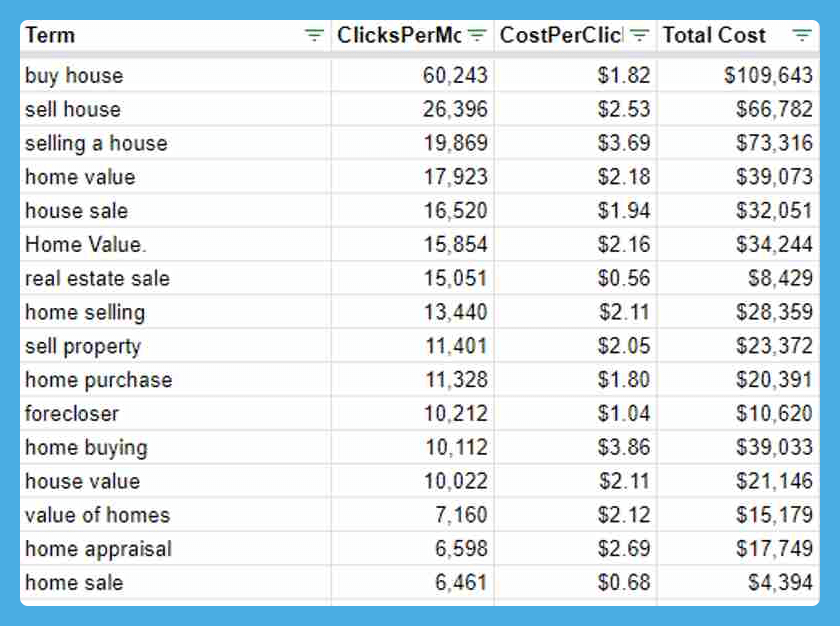
Opendoor already spent millions on their PPC ads and website promotion; they know exactly what works and what doesn’t in the REI advertising space. After all…
So you don’t have to reinvent the wheel.
Steal Opendoor’s marketing insights and apply them to your local market to become the go-to real estate investor in your state. If these principles work for Opendoor on a global scale, they will work for you on a local scale, too.
But first, download this swipefile of spying tools so you too can find out what ads your competitors are running…
[activecampaign form=29 css=1]
Then get ready to dive into the strategies and tactics of one of the biggest iBuyers in the world.
Opendoor is a relative newcomer in the real estate business.
Their aim is to bring simplicity to the housing market by purchasing homes directly from sellers and flipping them for profit after a quick spruce-up.
They’ve garnered major success as a new iBuyer on the market. In fact, in the period between January to October 2019, they’ve bought more homes than Zillow, Offerpad, and Redfin combined.
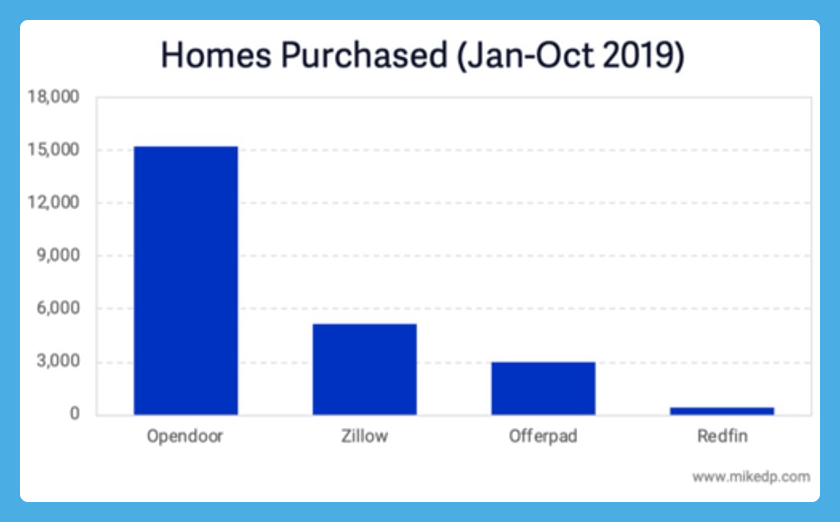
Source: https://www.mikedp.com/opendoor-ibuyer-business-model
This is a huge success for a startup that was founded in 2014… While their biggest competitors have been up to 10 years longer in the industry:
When it comes to buying and flipping homes, no one can beat Opendoor.
Their projected revenue for 2021 is $7.2 Billion at 13% margins. Which is more revenue and healthier margins than any other iBuyer — even Zillow at 6.4 Billion revenue* and 9% margins.

Source: https://www.mikedp.com/articles/2021/11/3/zillow-exits-ibuying-five-key-takeaways
Even though the pandemic shook many iBuyer, the market’s interest in Opendoor is still explosive:
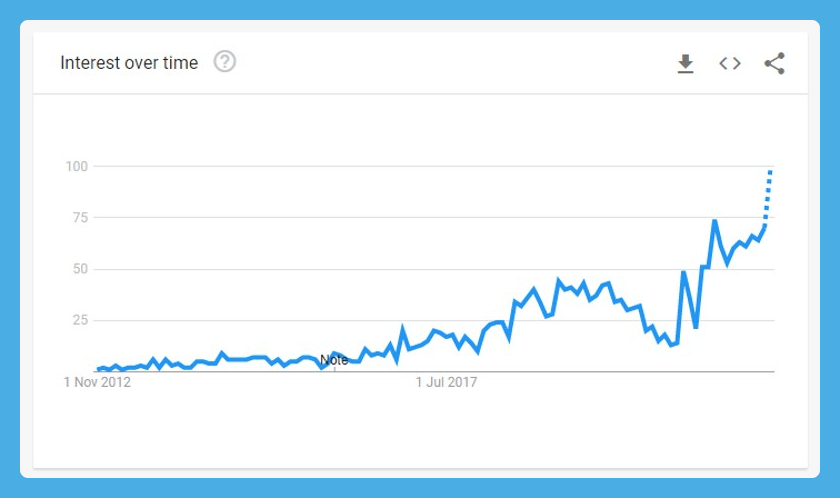
It won’t be long before Opendoor becomes the main player in the house-flipping space.
To understand Opendoor’s explosive success, let’s take a look at who’s behind the grand operation…
Their board of directors consists of A+ players who have previously worked with —what are now— world-leading companies:
Eric Wu — CEO, previous CEO of Movity.com, and co-founder of RentAdvisor.com.
Ian Wong — CTO, previously built machine learning applications at Square and Prismatics.
Andrew Low Ah Kee — President, previously COO at GoDaddy where he led a global team of 7,500 people.
Carrie Wheeler — CFO, previous partner, and lead investor at TPG Global, a world-renowned private investment firm, for 20 years.
Tom Willerer — CPO, previously CPO at Coursera where he helped scale the company from 1$ Mil to $100 Mil. Also, lead product teams at Netflix.
Combine their work experience with an innovative business model and you have a recipe for domination.
Before we fully dive into Opendoor’s marketing tactics, it’s worth understanding how they operate.
Primarily, Opendoor buys houses and flips them. They’re the middleman, “flippers”, in residential real estate transactions.
However, they are very careful about which house they buy.
Their qualified properties include single-family homes and townhomes built after 1930 valued between $100,000 and $600,000.*
Why these limitations?
Because it’s less risk for them if a deal goes astray.
My guess is that Opendoor realizes it’s more difficult to sell a house that’s worth more than $600,000. The high price point increases their time to sell, and because of the carrying costs, the longer the house is in Opendoor’s possession, the thinner their margins.
To stay competitive, Opendoor prefers to flip fast and often. According to their revenue model, it’s better to flip five $0.5 Mil houses instantly than one $2.5 Mil house after it sat in their inventory for months.
Besides high price point, Opendoor also stays away from homes that:
Since Opendoor makes all necessary repairs, has a 30-day satisfaction guarantee, and a 2-year home warranty, all of the above would end up eating their profit margin from additional repair costs, warranty costs, and carrying costs.
If you choose Opendoor for their real estate services, you can either
Starting with September 30, 2020, Opendoor charges a flat 5% fee on their services — for both buying and selling houses.
(Historically, the service charge started at 6% but could increase up to 14% for more risky properties. I believe they lowered their service charge to 5% fixed so they can reach additional competitiveness in the market that would benefit them in the long-term, even though this move ate into their margins in the short-term.)
It’s worth taking a deeper look into their service fee. With it, Opendoor is basically saying…
We think your house is worth $250,000. But we’ll actually give you $237,500 for it.
I mean…
Why not say their house is worth $237,500 from the start?
It’s a deliberate move — evaluating their customers’ house higher creates a feeling that Opendoor gives better offers than anyone else on the market… Regardless if they later take a fee which essentially decreases their offer to a more standard rate the seller would get elsewhere.
Plus, they can position themselves as being on your side.
Seeing they are fee-based gives you the impression that it’s in Opendoor’s best interest to give you the highest possible offer on your home — after all, they’ll take a service charge out of it. A bigger offer means a bigger service cut…
But at the end of the day, they still need to make a profit flipping. There is no business model where you spend more money on a product, sell it for less, and still make a profit. Even if Opendoor wants to convince you that their “money is in the service charge”.
Well played, Opendoor.
Opendoor realizes that the new digitalization of the real estate business is not something everyone is overly excited about — neither clients nor agents.
Buying or selling a house is an important moment where emotions run high. That’s why Opendoor allows their clients to have outside agents help them through the process if they wish.
While at the same time they invite agents to use Opendoor as a convenient tool in their real estate utility belt.
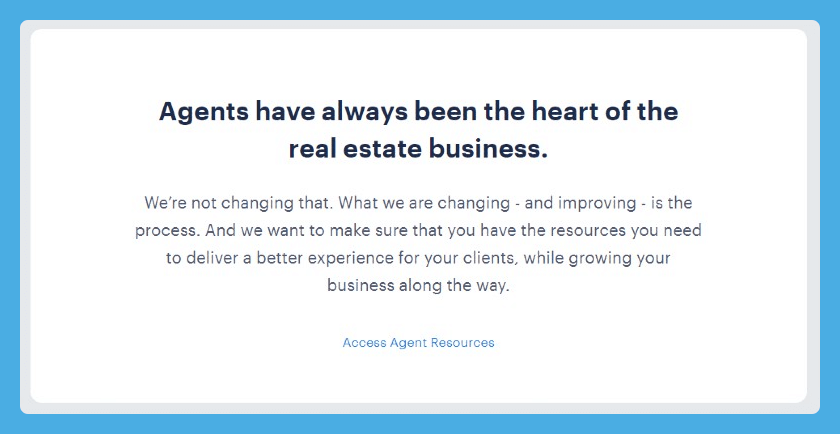
(source: https://www.opendoor.com/w/agents)
Whenever an agent convinces a client to either sell or buy from Opendoor, the agent gets a full buyer or seller commission. This helps Opendoor get a ton of referrals and brand awareness for their business, and I believe it’s a big reason why all Opendoor’s marketing channels are so successful.
After all, if you have everyone in the REI industry —even agents— talk about Opendoor then that creates so much social proof and peer pressure that it could, in the long term, even change the buying and selling behavior of the entire population.
To put some weight behind this thesis, let’s dig into the numbers Opendoor is getting from its marketing channels.
Opendoor has just one website: opendoor.com, to which they’re getting nearly 2 Million monthly visitors.
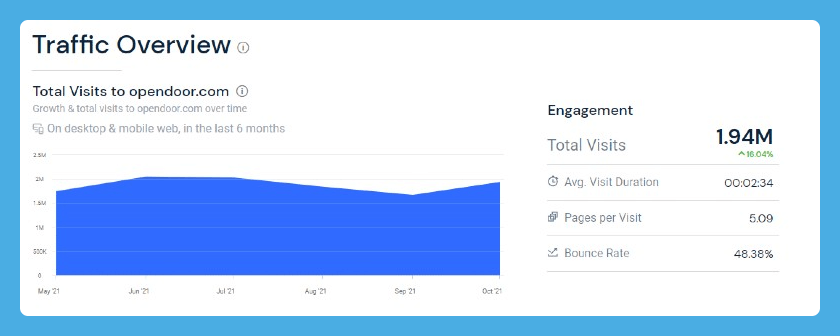
An average visitor spends nearly 2 minutes 34 seconds browsing their website and checks out 5 pages per visit…
This is nothing short of astonishing.
Such great engagement at such high traffic numbers can mean only one thing: Opendoor is attracting very relevant, very engaged traffic to their website and is hyper-serving them valuable content so they stick around.
I mean, that’s 0.6% of the US population checking out Opendoor every month.
Speaking of the US, nearly all their traffic comes from there. This isn’t a surprise as that’s where they operate…
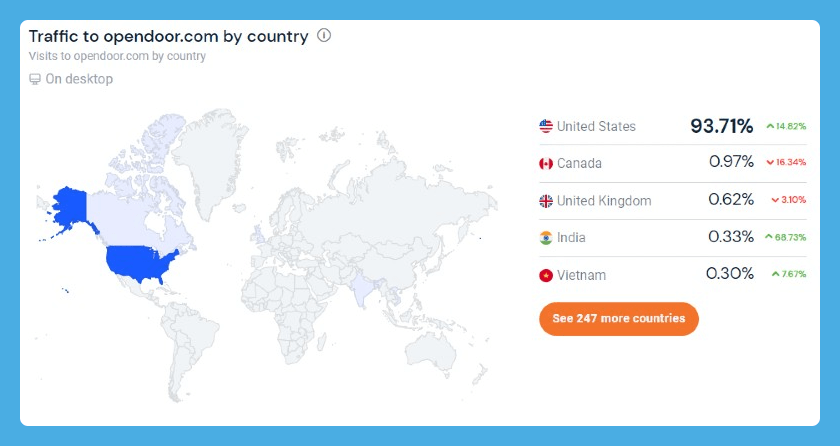
They’re also getting a trickle of traffic from other countries as well. One explanation for this is that all these people are interested in buying a house and moving into the states, and are doing their research.
But if we just focus on the US, things get interesting when we check Opendoor’s traffic sources:

Their referrals, social, mail, and display channels don’t make a lot of noise, but we should definitely take a closer look at their Direct and Search traffic.
*Pop your email below to reveal the website analytic tool I’ve used to get this data*
[activecampaign form=29 css=1]
Although the bulk of Opendoor’s organic traffic comes from branded keywords like “Opendoor”, their blog isn’t something to sleep on.
They’re using a simple-but-effective content strategy called “pain-point SEO” where they take all possible questions, concerns, and objections a home buyer or seller might have… and write better answers than anything else found online.
With this, they automatically nurture potential customers, educate them on the home selling process, and push them further down the funnel towards the “get a free offer” button.
Once this content is written, not only do they drastically decrease the workload on their sales reps, but they also get free traffic and brand awareness from Google.
Check how much monthly traffic they’re getting to some of their articles.
(Note that the tool I’m using underestimates the actual data by 4-5x.)
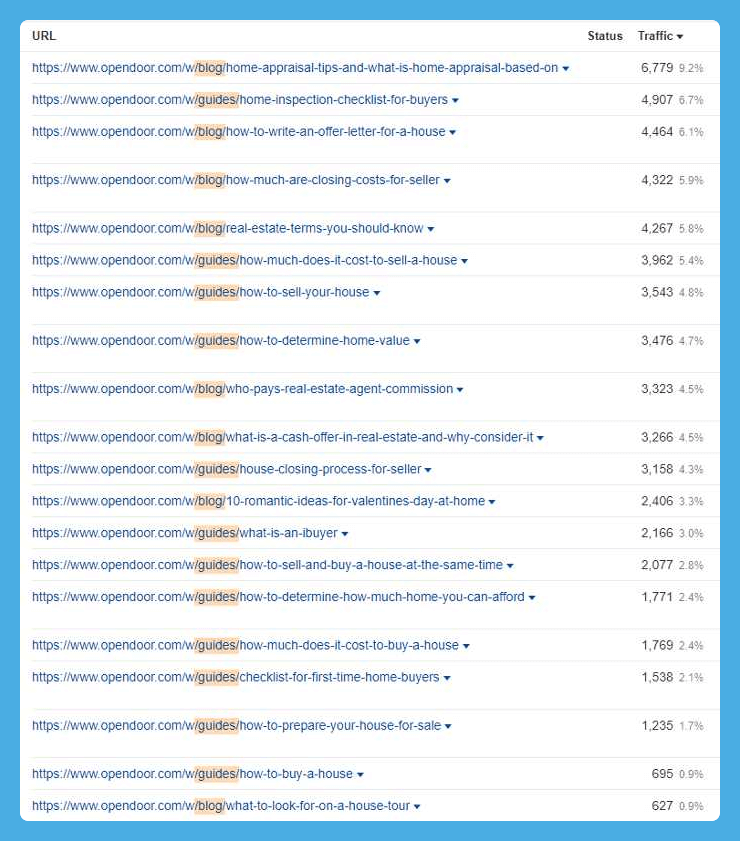
Because topics like these are specific (a.k.a. long-tail), they have little competition and rank very fast. This means the ROI per effort they’re investing into their blog is huge.
Don’t be fooled by high amounts of Opendoor’s direct traffic.
Direct traffic isn’t magical free traffic that falls from the sky. High direct traffic is a result of a big PPC budget. And with a budget of over half a million dollars per month, it’s not surprising to see those percentages.
We can learn a ton from the way Opendoor handles their paid traffic. That’s why, for the rest of this article, we’ll be breaking down every little detail of Opendoor’s PPC strategy — specifically Google Adwords.
You’d expect that someone who spends more than half a million dollars per month on PPC advertising has a complex system with lots of different ads and landing pages…
But that’s not the case with Opendoor.
They have ONE landing page, ONE ad copy, and very broad keyword targeting.
Here’s how their entire PPC funnel looks like:
They are bidding almost exclusively on broad keywords related to buying and selling houses, with some attempts at targeting local search and competitors.
Besides that, they:
Their ad copy is simple, yet sophisticated.
In the past, they’ve A/B tested a lot of different messaging and ad copy and have figured out to which the market responds to the most. This messaging can now be seen in every ad they run.
Coincidentally, this messaging also fits the search intent of a very broad set of keywords: which means that even though they essentially run one ad copy for all their keywords, their ad relevance and ad quality score is still high.
They have just one landing page for customers throughout all stages of awareness.
Besides the simplistic design, this works for them because they leverage every single type of social proof available:
Let’s take a closer look at each part.
In the real estate industry, keyword selection isn’t nearly as important as you think.
In fact, there is no secret list of keywords you should target.
So take Opendoor’s keyword strategy with a grain of salt — everything they’re doing is what’s working for them, in their market, with their landing page, and their budget.
The only way to know what’s going to work for you is through experimentation and optimization.
Why?
Because Google Adwords is an auction: the cost of clicks (CPC) on your ads depends on how many of your competitors are trying to go after the same keyword in the same location on the same day as you are.
That’s why the key to getting great results with Google ads is buying keywords that are underpriced in your market today.
But because competition and search volumes vary, so do ad costs.
That’s the reason why Opendoor bids heavily on keywords that perform well for some months, but then suddenly ghost when competition increases.
Notice the gaps between ads in this picture. They signal how much time has passed between ads running for a certain keyword where one “ad width” is one month:
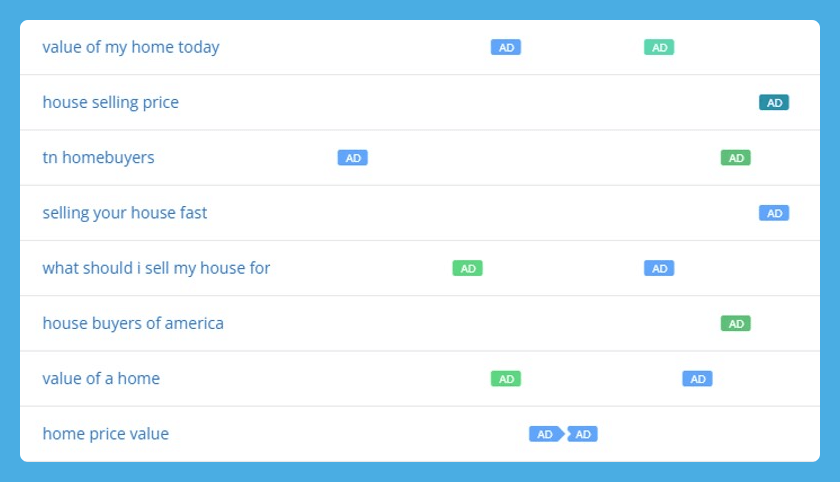
To dig into this example, here’s the ad they run for “what should I sell my house for” in March 2021:

And here’s the ad, relaunched for the exact same keyword, later that year in August:
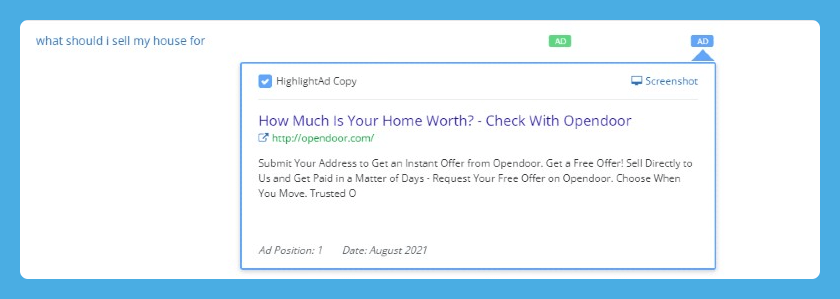
*Pop your email below to reveal the PPC Spy tool I’ve used to get this data*
[activecampaign form=29 css=1]
They are nearly the same.
Now there are three ways I can explain this:
Although I can’t know for sure, I feel like point #3 is the most likely scenario.
Now, as far as their keyword selection goes, they are targeting four big categories: head terms, long-tail, competitor, and location-based keywords.
The vast majority of searches in the REI industry are centered around a few head terms that everyone is searching for.
For example “sell my house” or “buy my house”.
Both of these terms have a lot of monthly search volume in the US…
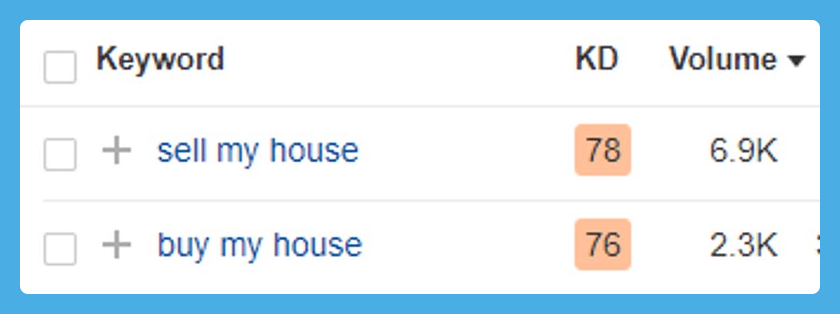
… And both tire-kickers and hot leads are typing this into Google.
Unsurprisingly, Opendoor is investing the biggest chunk of their PPC budget into these head teams, and are naturally getting the majority of clicks from them.

Surprisingly, they are getting some very good Cost Per Click (CPC) on these keywords.
My guess is that this is because of the “target area” effect.
Since Opendoor is targeting most of the United States with a giant budget, the Google algorithm is able to generate clicks later in the day (when there’s less competition), and in less-competitive areas.
This drives down the average CPC. This isn’t the case for investors who target a single expensive metro: their CPC can get extremely high.
Also, because Opendoor is offering an extremely low-risk proposition (online home evaluation, rather than a phone call or meeting), they can afford to use broad match keywords like these, which generate “noisier” traffic (more off-topic searches).
My guess is that this is because the ratio between volume and competitiveness is in favor of the volume. In supply and demand terms, there is currently more demand (search volume) than supply (paid ads) for selling a house.
Now let’s take a look at what results Opendoor is getting from bidding on more specific phrases.
Many marketers tell you that you should go after long-tail keywords because “the longer the keyword, the more motivated the buyer”.
For example, the keyphrase “sell my house fast” is more specific and thus attracts more motivated sellers and higher quality traffic than “sell my house”.
This is all fine and dandy, but there’s a big problem with most long-tail keywords.
And that is that everyone knows about them.
Just take a look at the huge CPC for the following two long-tail keywords Opendoor is bidding on…
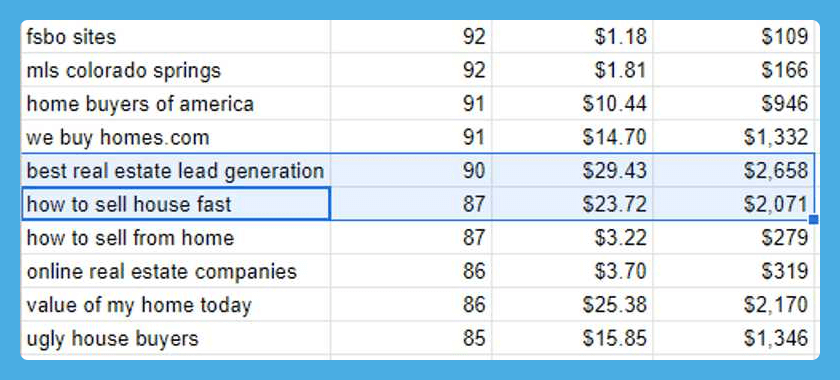
If we check their monthly search volume in the US, we can see that it’s far below 1000…
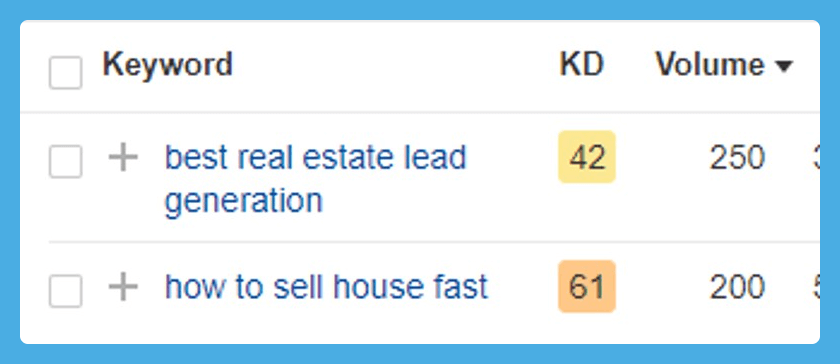
*Pop your email below to reveal the SEO Analytics tool I’ve used to get this data*
[activecampaign form=29 css=1]
But not only that, every real estate agent knows that the users behind these keywords are highly motivated sellers, so they’re all trying to go after them.
Low search volume (demand), many paid ads (supply).
And we get huge CPC.
So sure, the long-tail keywords might generate fewer tire-kickers for Opendoor, but is it worth the higher price?
It certainly seems so for Opendoor. But only you can answer if that is true for your business as well.
These are simply keywords that contain a location prefix.
For example:
I believe Opendoor is running aggressive local search campaigns targeting these keywords whenever they are either expanding to a new market or are trying to increase their inventory in that location fast.
For example, in the midst of the pandemic in 2020, Opendoor decided to sell its inventory and stopped buying houses. Since then, they’ve invented new ways of selling houses remotely and have opened their doors to the public once again in early 2021…
This means they needed to restock — fast.
Their purchase activity increased massively around Q4 2020:
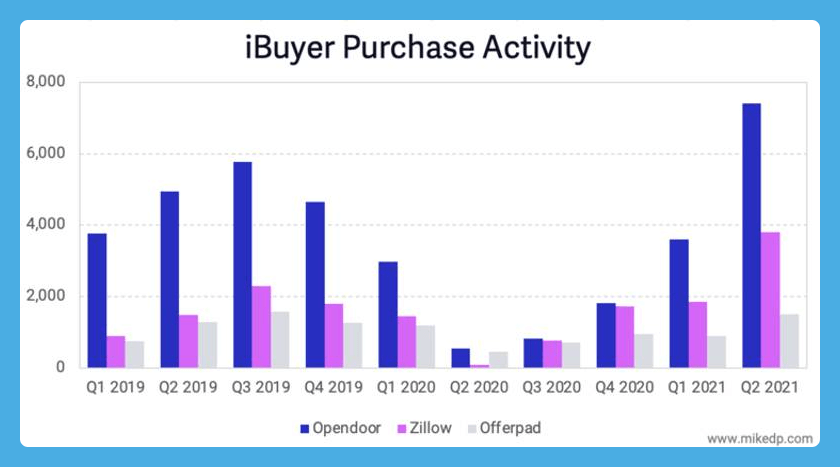
This coincides nicely with the number of ads they’ve run in Phoenix between July 2020 and May 2021.

Then they’ve stopped abruptly in June.
Why?
My guess is that they either got their inventory back to sufficient levels or they found out that location-specific ads aren’t profitable (which is unlikely.)
Overall, location-based keywords are amazing for getting leads in the market that you operate in. With them, you can achieve a lower CPC than you otherwise would have by targeting “global” head or long-tail keywords.
Opendoor is also bidding on competitor keywords — but with a twist.
Because exact match branded keywords (like “zillow”, “redfin”, “offerpad”, etc.) are the obvious go-to choice for agents and investors, they are also more competitive.
That’s why Opendoor is layering their branded keywords with URLs, typos, and location modifiers
For example, here are some of the keywords Opendoor is bidding on their competitor, Redfin…

And Zillow…

As you can see, they are purposefully excluding the exact branded terms, “Zillow” and “Redfin” — I couldn’t find any bids on them in 2021.
Opendoor’s most common ad, by far, is this one:

It accounts for 41% of all ads served. Since Opendoor is spending $650,000 on ads each month, this must be some very perfected ad copy.
Strangely, all their other ads aren’t much different from this one.
Here’s is the headline copy that pops up over and over again:
It appears that Opendoor discovered the perfect angle for attracting people selling their houses: figuring out “how much their home is worth” and the fact that they’ll get the answer in “just 3 minutes”.
Opendoor didn’t come up with this angle overnight. I’ve managed to find some banner ads they were running throughout the years to test various advertising angles. Here are just some of them:
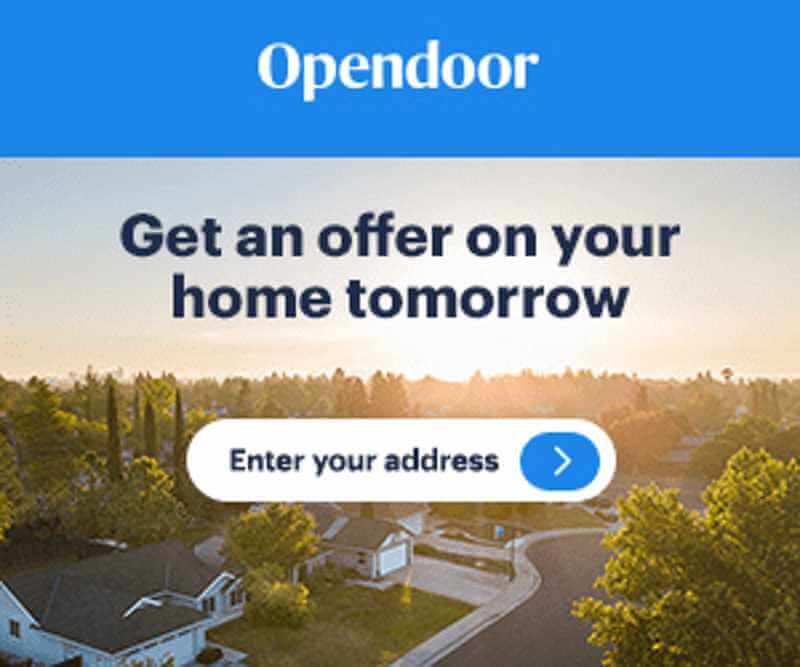
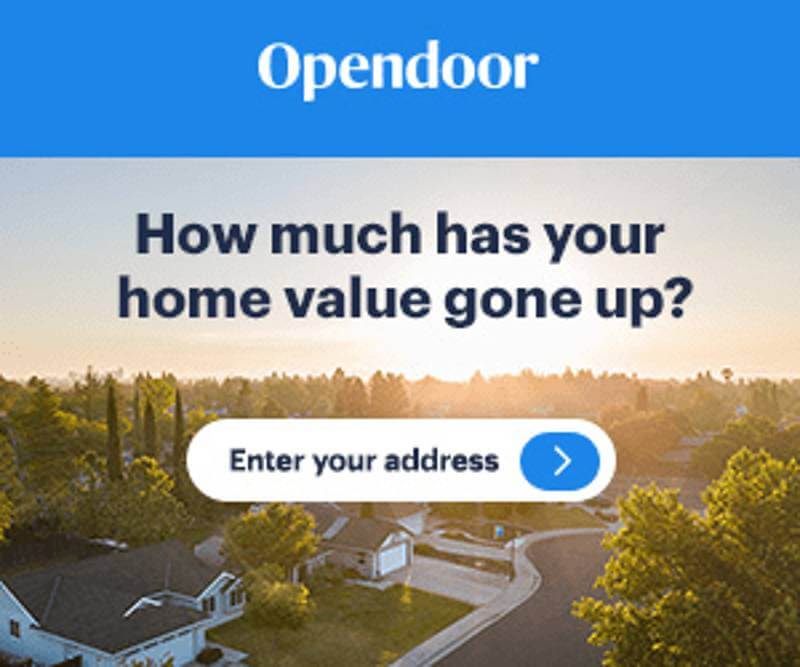

Their longest-running banner ad (from 10 July 2018 to 7 March 2020) was using copy with the super specific “speed” angle, which proves this must be their best performing angle.

*Reveal the Banner Ad Spy tool I’ve used to get this data by entering your email below*
[activecampaign form=29 css=1]
We can see that even a company as big as Opendoor spends months and even years testing out the best advertising language before scaling up. Meaning: don’t be afraid to test the waters and get discouraged if your return-on-ad-spend (ROAS) is not where you expect it to be in the beginning.
As we saw, Opendoor already discovered that the best performing angle in the REI market is “checking how much your home is worth — fast”. Now they are fine-tuning their ads by tweaking the copy in the body.
Take a look at the following copy here:
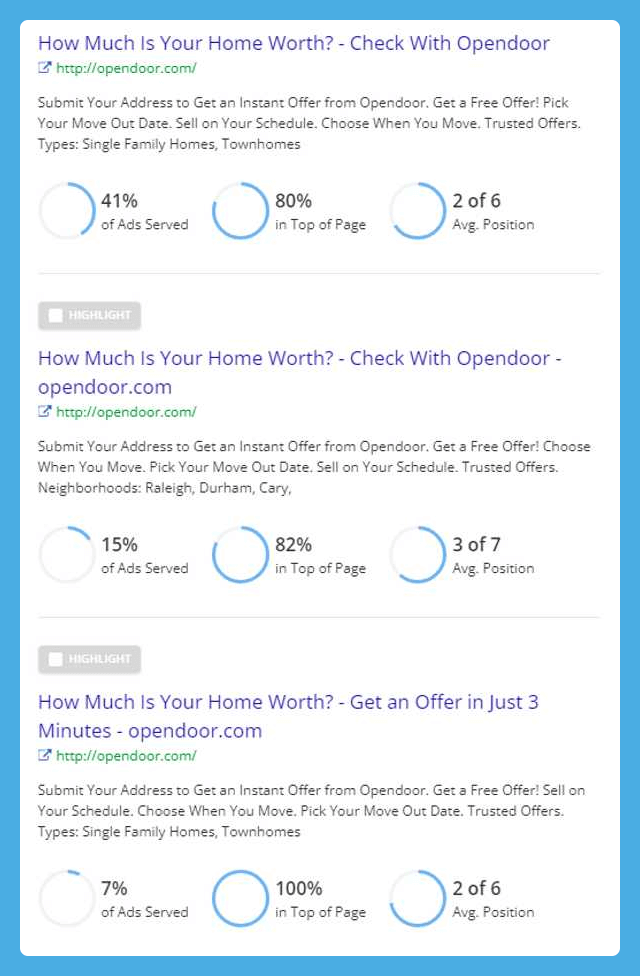
Although the first part of the body copy is always the same (“Submit Your Address to Get an Instant Offer from Opendoor. Get a Free Offer!”), the second part changes very, very often.
Here is the body copy they are split testing as of December 2021:
This data gives us a beautiful insight into their A/B testing methodology.
Opendoor realizes that to make an ad work, it has to:
Here’s a flow chart of this methodology that you can follow and apply in your business.
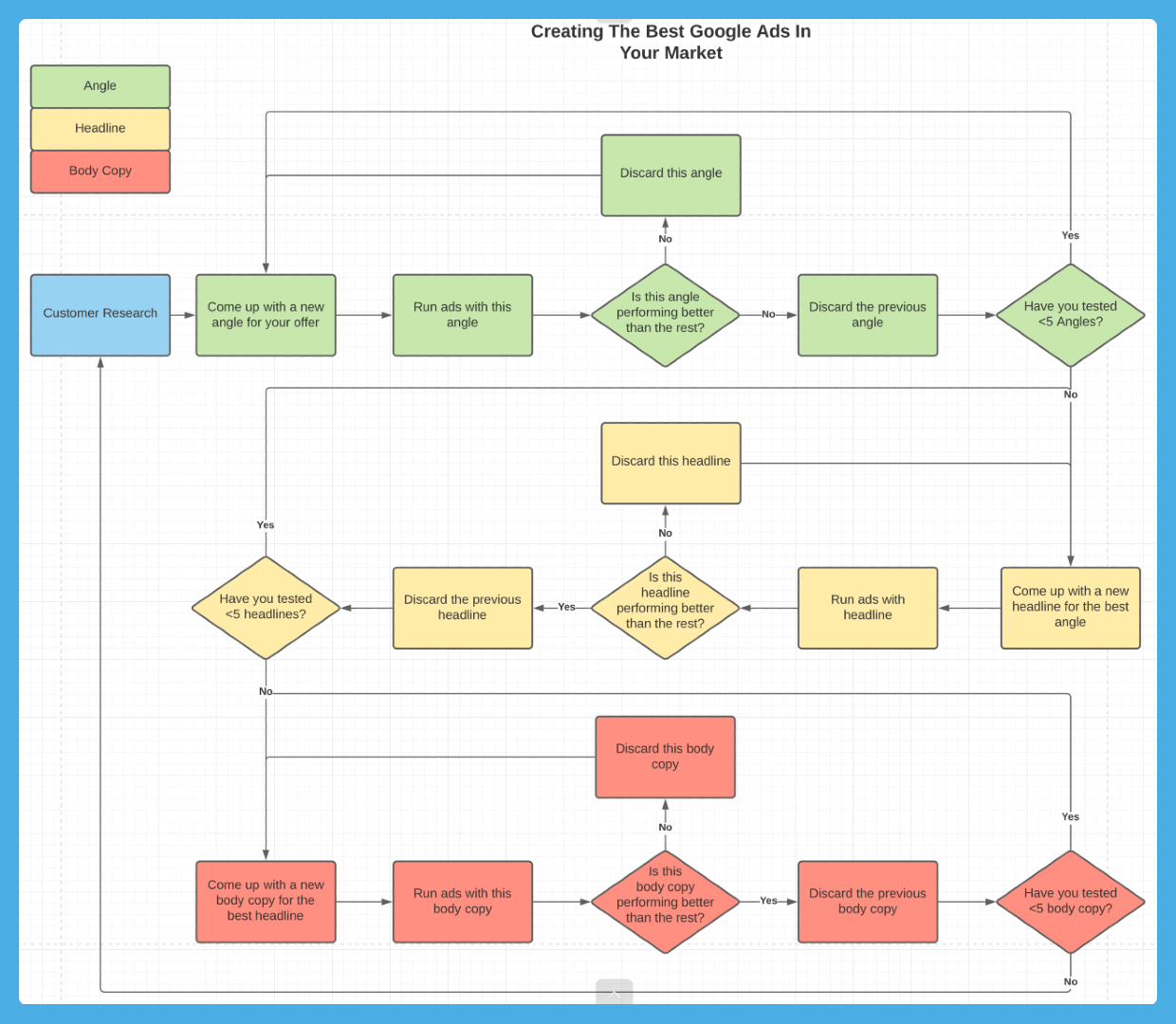
Ask any Google Adword expert and they’ll tell you that you should —ideally— create one landing page for each keyword you’re going after. This is so that you can tailor the page to better match the search intent behind your keyword…
But if we check the keywords Opendoor is bidding on they are all either closely or somewhat related to selling a house…
Which is why Opendoor decided to drive all their traffic to one landing page: their homepage.
Because of this, their homepage doesn’t have the typical navigational design but is hyper-optimized for converting cold traffic into leads.
This is what we see above the fold when we visit opendoor.com:

Check the header. There are only two links leading to other pages: one to buying a house and one to asking for a loan.
There is no sign of a “blog”, “about us”, “contact us”, or “pricing”…
Opendoor is hyperfocused on just one thing: getting the visitor to request an offer for their home — and every element here is working towards that goal
#1 the copy is a reflection of what we already know: the house sellers resonate most with the angle of getting an offer on their house and selling it FAST.
#2 This is further explained in the sub-title copy which offers even more specifics: “get an offer in minutes, sell in days”.
#3 The input form where the user enters the address of the house with a button calling for “get my free offer” is extremely simplified to remove any friction that might turn off the visitor from finishing their action. Moreover, including “free” further signals that the visitor has nothing to lose.
#4 There’s a lot going on in the brand bar as well. Opendoor is showcasing testimonials from brands that are highly recognizable and influential in the US. In the far right section of this bar, they’ve also included a BBB accredited business trust badge to show that they are approved by third-party security organs and that they are a safe partner to trade with.
Now this social proof and the benefits are great and all… But a common problem with many REI websites is that they focus too much on listing the benefits of their service without explaining “the how”.
This is a problem because a benefit without a feature rings hollow since the visitor isn’t familiar with the process you will use to deliver what you’re promising.
Which creates uncertainty.
That’s why Opendoor’s next section clearly explains how the process of selling your home works.
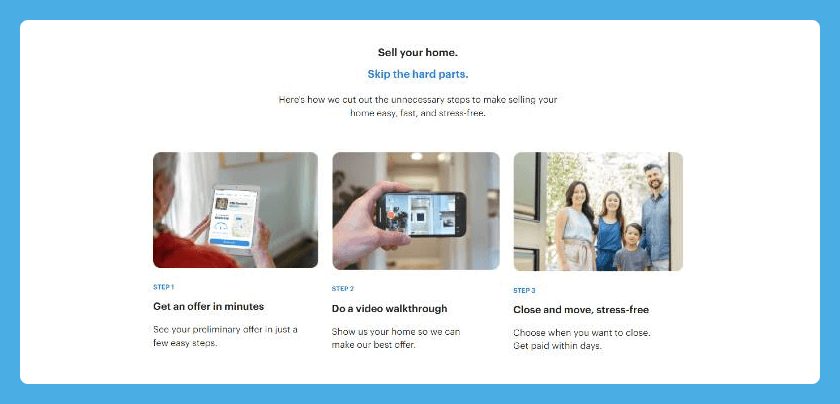
They’ve boiled their home selling process down to three essential steps:
There might be some additional steps in between, but as far as their process goes at this stage, you know exactly what you can expect after you click “get my free offer”.
It’s not extensive, and that’s deliberate.
But what’s truly genius about this section, in my opinion, are the pictures calling out their ideal customer and subconsciously dispelling any objection they might have:
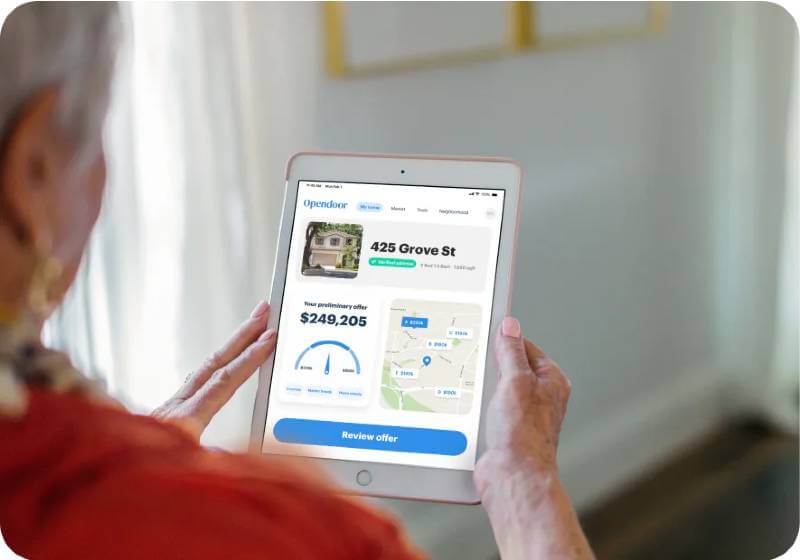
The first picture above “get an offer in minutes” is showing an elderly woman (earrings, white hair, and hands that are obviously of an elderly person) looking at Opendoor’s offer on a tablet. We see that the offer is structured with just three elements, clean UI, and seamless UX..
This picture is essentially saying that you don’t have to be tech-savvy to get and understand an offer from Opendoor and that the process is so straightforward anyone could do it.
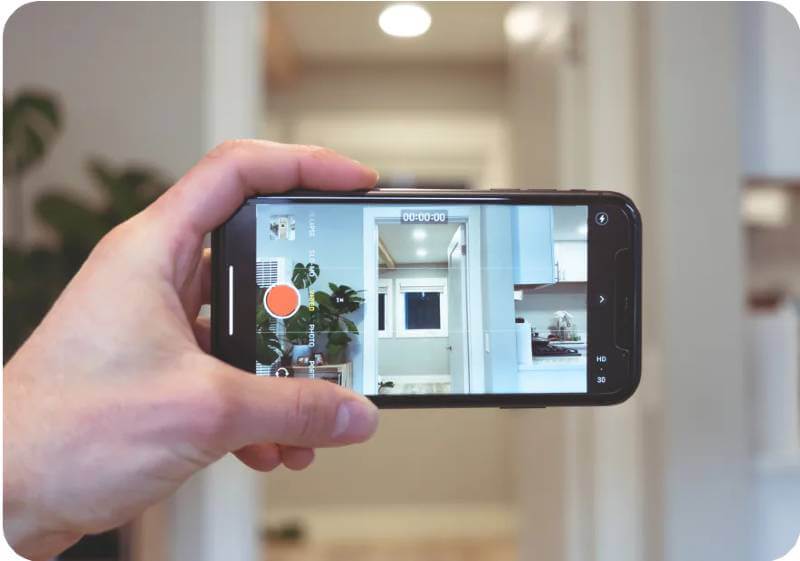
The next picture about doing the video walkthrough is showing a phone that looks affordable. It’s not a high-end gadget or luxurious — but something anyone could use.
With this, Opendoor is signaling either that they do business with lower to middle-class families who own and want to sell houses in Opendoor’s acceptable $150k to $600k price range, or that you don’t need high-end tools to get a valuation on your house.
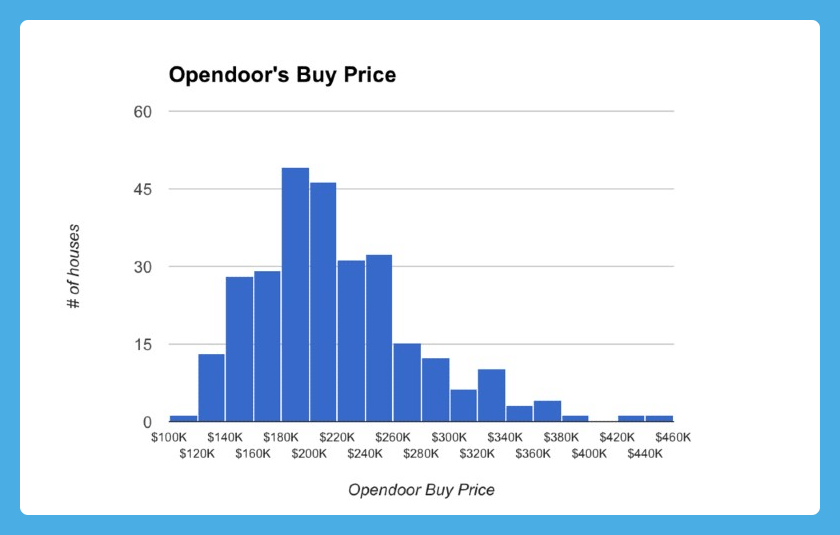
Finally, the last picture is a picture of a young family —Opendoor’s ideal audience— who just moved into their new house.

With the happy children and greenery in the front yard Opendoor is saying that if you do business with them your children will grow up in a safe and natural environment — something every parent wants.
Also notice how everyone is wearing blue and white clothes — which makes this picture blend in seamlessly and reinforce Opendoor’s branding.
The bottom line is this: Opendoor is masterfully selecting pictures for their website. They know that a picture is worth a thousand words and I bet there are some details and ideas behind these pictures that I’ve missed.
Moving on to the next section…
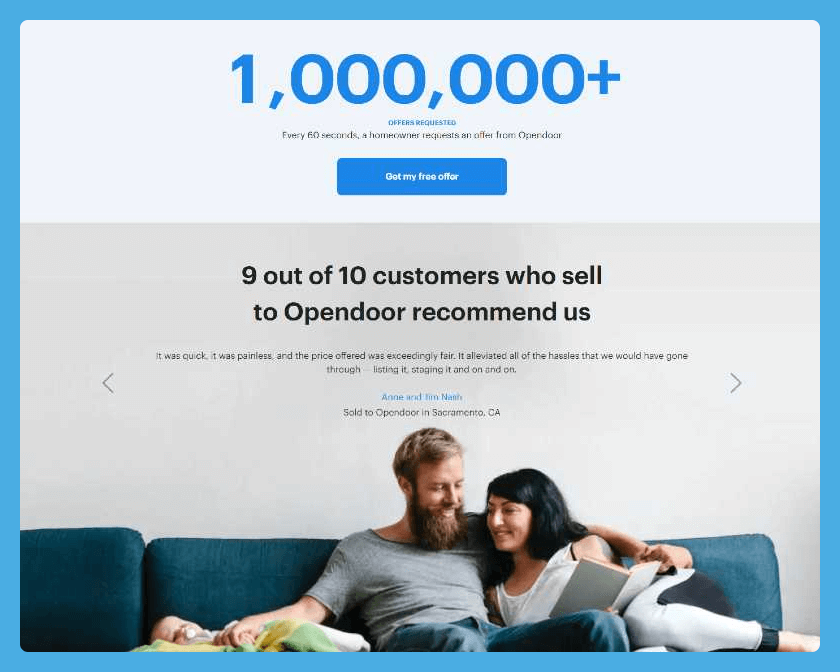
We have the first call-to-action button in the page body. Similar to the first CTA, this one also has a lot of social proof in its vicinity.
But, this time, the social proof is mostly statistics-based. And we see not one, but three types of statistics here:
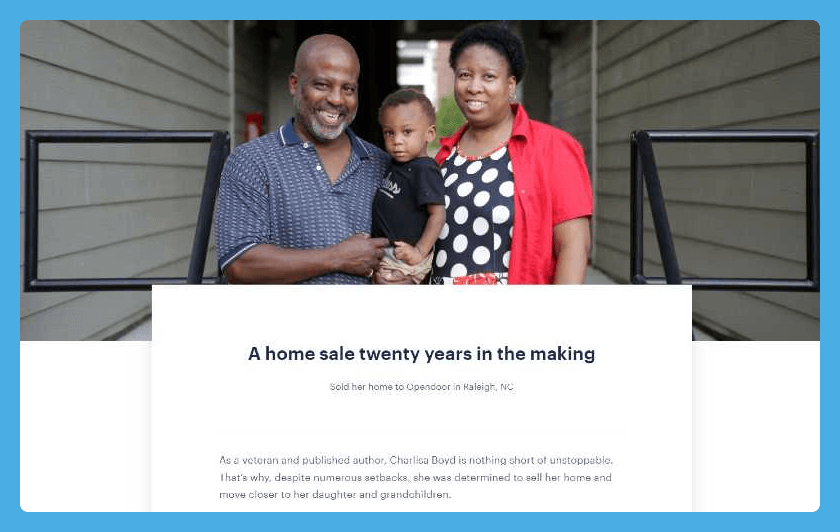
The next section has two offers for selling your home — selling it to Opendoor (the offer we’ve seen everywhere throughout the homepage) and listing it with Opendoor.
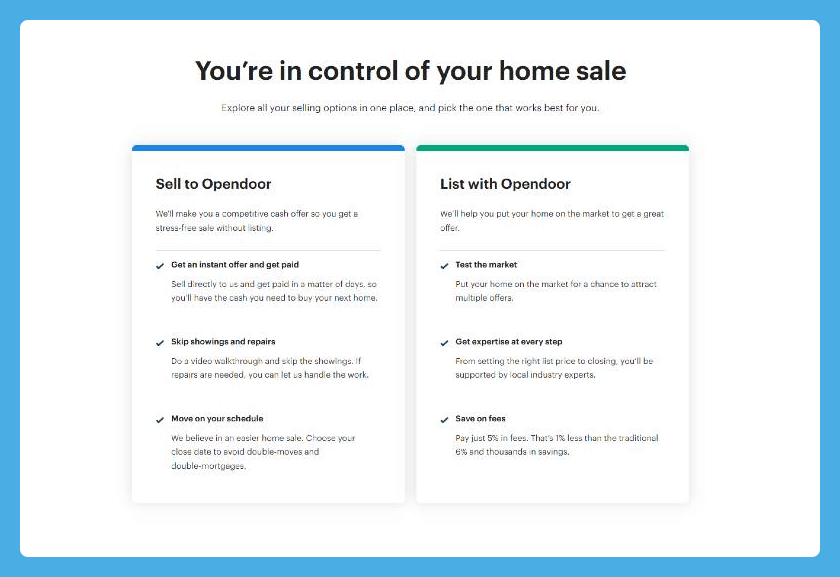
What’s interesting is that we’re already pretty far down the page and this is the first time they even mention the fact that you can also list your house with Opendoor.
It appears this is not their preferred offer.
Opendoor would rather see you sell your home directly to them so they can flip it themselves. That way, not only do they get more commission fees (5% upon buying + 5% upon selling as opposed to just a flat 5% for listing), but they also make, on average, 5.5% of base house value with each re-selling:
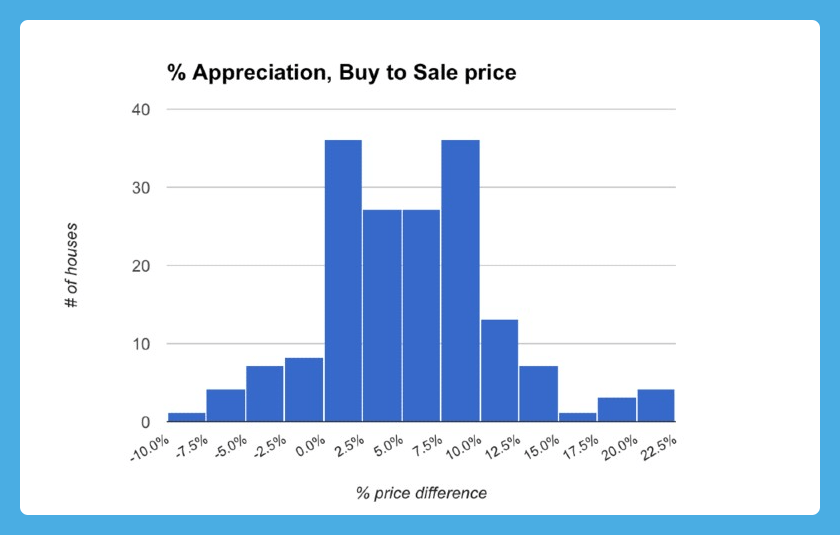
In the next section, we finally get it: an offer for those who want to BUY a home.
The entire home-buying section is 24 words long, and that’s about as much as they were willing to invest in home buyers.
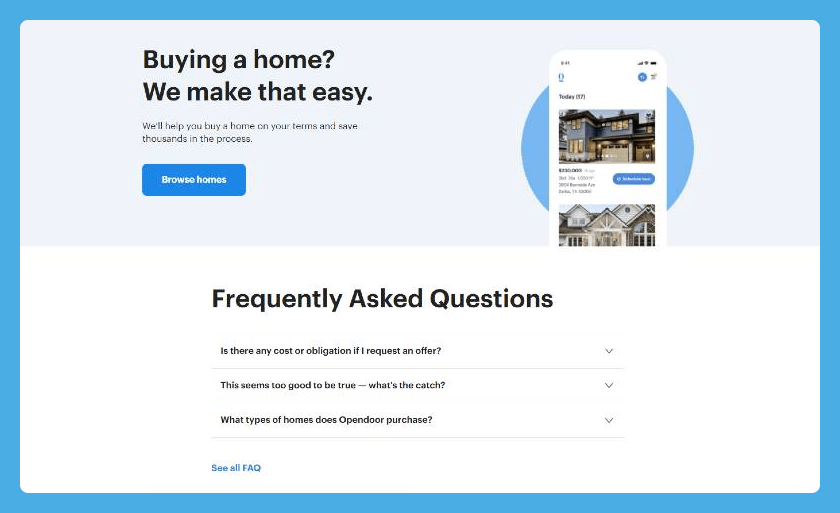
It seems like Opendoor has no problems finding customers for buying their homes through other traffic sources (in fact, they’re getting 350,000 organic visitors to their https://www.opendoor.com/homes page every month directly from Google.)
Below that is a FAQ section, which is tightly related to the free offer. This is Opendoor’s last resort to handling any objections their visitors might still have — including the fact that their offer might seem “too good to be true”.
And if that didn’t convince you, Opendoor gives the option to either contact their support via email or phone, or opt-in to their mailing list and get “expert tips in your inbox”.

Both of these options are placed conveniently next to each other and not stacked on top.
CTAs like these give the impression that the reader has reached the end of the page. So if, for example, “Contact Us” was placed above “Expert Tips” then a portion of readers who don’t want to contact Opendoor yet, would leave before seeing the email signup option.
As I’ve said, Opendoor’s homepage is hyper-optimized for conversions — and minor details like this only prove the hypothesis.
If you don’t have the time, expertise, or desire to manage Google Ad for your business, we can help you.
Using our innovative account builds and data analysis, we ensure you’ll always be one step above your competition in your market and get the highest quality leads at the most affordable price.
Here’s what you need to be successful with our strategy:
Some of our past results we got for our clients (read more here):
13 leads, multiple deals on a tight budget

64 leads, multiple deals in highly competitive market

380 leads in 30 days, across multiple markets

If you meet the above criteria and have a serious desire to scale your REI business, schedule a Free strategy session with my team today.
In the competitive landscape of digital marketing, understanding how to effectively track conversions in Google Ads is crucial for maximizing your advertising ROI. This blog post will explore the intricacies of Google Ads conversion tracking, the importance of conversion events, and strategies for optimizing them to enhance your campaign performance. The Significance of Conversion Tracking
In the competitive world of real estate, generating high-quality leads is essential for success. Pay-Per-Click (PPC) marketing has emerged as a powerful tool for real estate professionals looking to attract potential buyers and sellers. However, the effectiveness of PPC campaigns hinges on understanding the nuances of the market and the specific needs of potential clients.